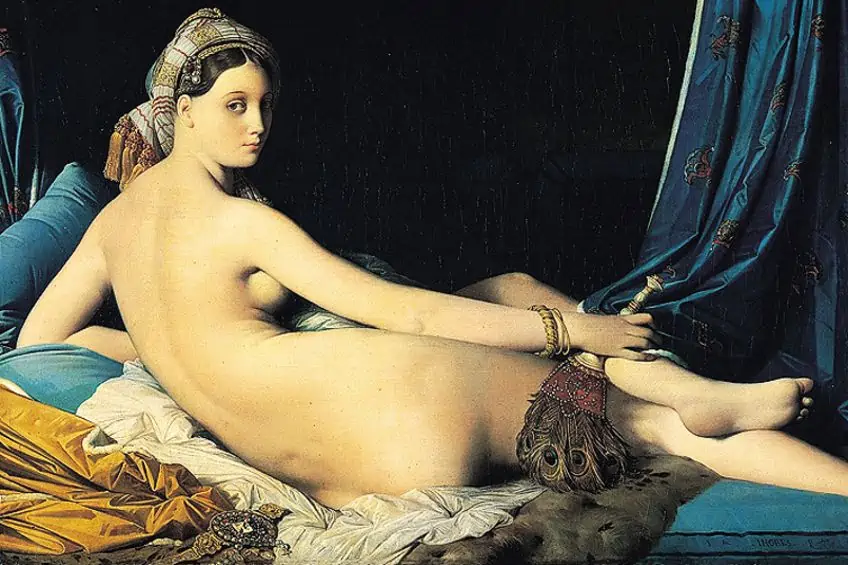Famous Paintings of Women – The 15 Most Famous Female Portraits
Throughout the history of art, women have always been featured as prominent subject matter. From saintly subjects, nude goddesses, beautiful female portraits, lounging aristocrats, and everything in between; women have been there. In this article, we explore famous paintings of women, done by men as well as women; starting from the earlier Renaissance period when women in art played a very different role to women in art during the Modern era.
Contents
- 1 Women in Art
- 2 Our Top 15 Famous Paintings of Women
- 2.1 The Birth of Venus (c. 1484 to 1486) by Alessandro Botticelli
- 2.2 The Mona Lisa (1503) by Leonardo da Vinci
- 2.3 Venus of Urbino (1534) by Tiziano Vecellio (Titian)
- 2.4 Judith Slaying Holofernes (1614 – 1621) by Artemisia Gentileschi
- 2.5 Girl with a Pearl Earring (c. 1665) by Johannes Vermeer
- 2.6 La Grande Odalisque (1814) by Jean Auguste Dominique Ingres
- 2.7 Liberty Leading the People (1830) by Eugène Delacroix
- 2.8 Olympia (1863) by Édouard Manet
- 2.9 Whistler’s Mother (1871) by James McNeill Whistler
- 2.10 The Cradle (1872) by Berthe Morisot
- 2.11 Woman with a Parasol (1875) by Claude Monet
- 2.12 Portrait of the Artist (1878) by Mary Stevenson Cassatt
- 2.13 Portrait of Gertrude Stein (1905 – 1906) by Pablo Picasso
- 2.14 Portrait of Adele Bloch-Bauer I (1907) by Gustav Klimt
- 2.15 Self-Portrait with Thorn Necklace and Hummingbird (1940) by Frida Kahlo
- 3 Women in Art and Art in Women
- 4 Frequently Asked Questions
Women in Art
Since the dawn of time women have been, if not the primary, important subjects in art. Going as far back as over 20, 000 years ago, we see the veneration of the female figure, possibly as a model of fertility. One of the earliest and most famous examples includes the Venus of Willendorf (c. 24, 000 to 22, 000 BCE). However, we see this accentuation of the female attributes in hundreds, if not thousands, of art artifacts from multitudes of cultures.
Female art from Egypt, for example, portrayed women in the role of the mother, but also in other familial roles like wife or daughter. Women were also represented according to their status in life. We will also see women in art from the Greek and Roman eras, portrayed in their roles within the societal systems as mothers and caregivers.
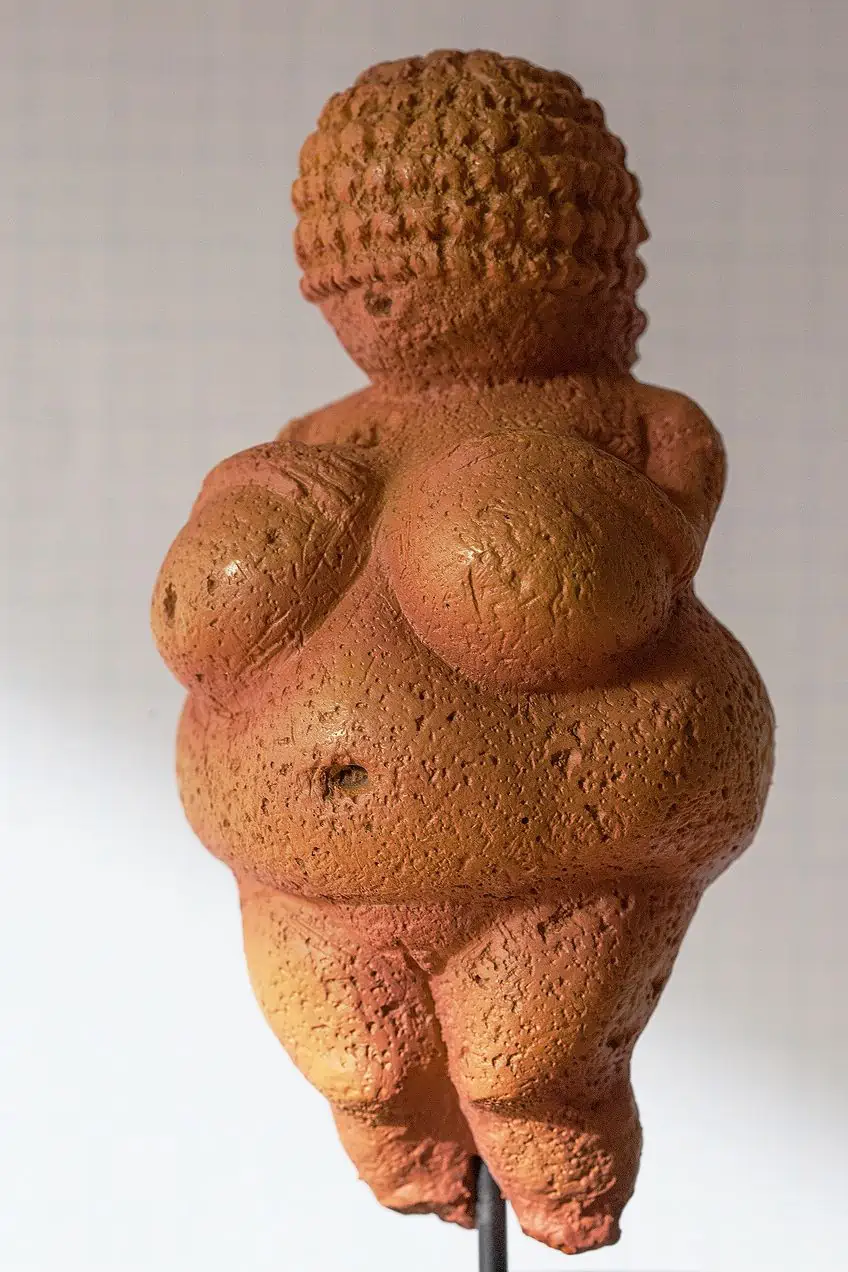
Some of the other dominating themes around paintings of women during the ancient times revolved around them being portrayed as deities, objects of desire like the goddess Venus, or monstrous villains found in Greek mythology.
Women have been portrayed as delicate, beautiful, illustrious, saintly, soft, and almost all the traits related to femininity. However, it has not been an easy road for women and their role in art. They have been placed on pedestals and shunned to the sides in a world where patriarchy paved and painted the way.
When we look at art during the Middle and Renaissance periods, women reprised their places determined by status, society, economy, and religion. The female figure was of particular interest during the Renaissance period, as it was idealized as an example of beauty and perfection, and was perfectly toned and contoured.
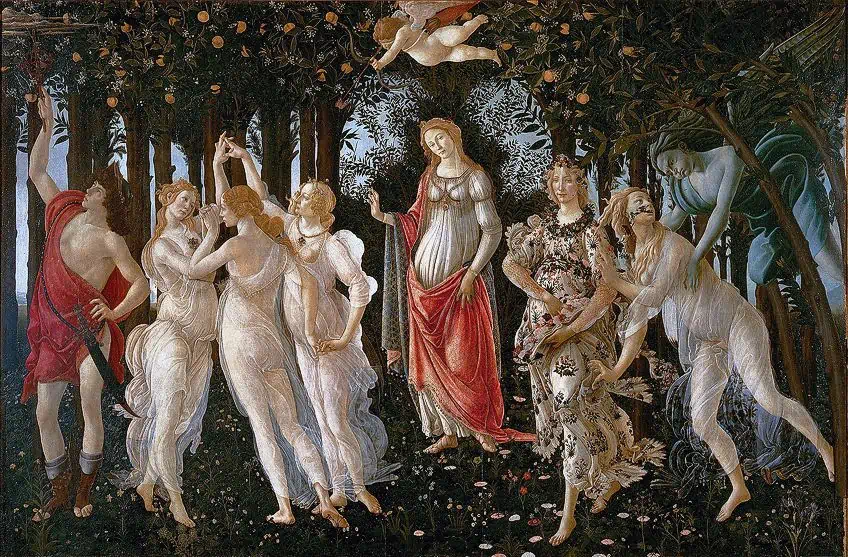
The subject of nudes was predominant, albeit in a sensually aesthetic manner, and not so much a “naked” provocative manner. We see women in mythology illustrated by artists like Alessandro Botticelli, who depicted Venus in two famous paintings, namely Primavera (1482) and The Birth of Venus (c. 1484 to 1486). None other than Leonardo da Vinci depicted women from religion, namely Mother Mary, for example, Virgin of the Rocks (c. 1483 to 1486).
However, women were not merely meek in their portrayals, as we see strength in their beauty, depicted in the wooden sculpture, titled Penitent Magdalene (1453 to 1455), by Donatello, and the marble sculpture Pietà (1498 to 1499) by Michelangelo, both showing the religious figure of Mother Mary. Notice the strong muscular physicality in Donatello’s Penitent Magdalene, a wholly different portrayal compared to Venus’s voluptuousness.
As the Renaissance period developed into the Modern era, women in art became freer and more fluid; their roles were upturned.
Impressionists like Édouard Manet provoked the masses with his famous Le Déjeuner sur l’herbe (1863) and Olympia (1863) paintings, while Pierre-Auguste Renoir’s Luncheon of the Boating Party (1881) depicts women among men in their fashion and fun during the 19th-century Parisian life. We also see artists like Edgar Degas depicting the everyday woman, an example includes his Woman in a Bath Sponging Her Leg (c. 1883 to 1884).
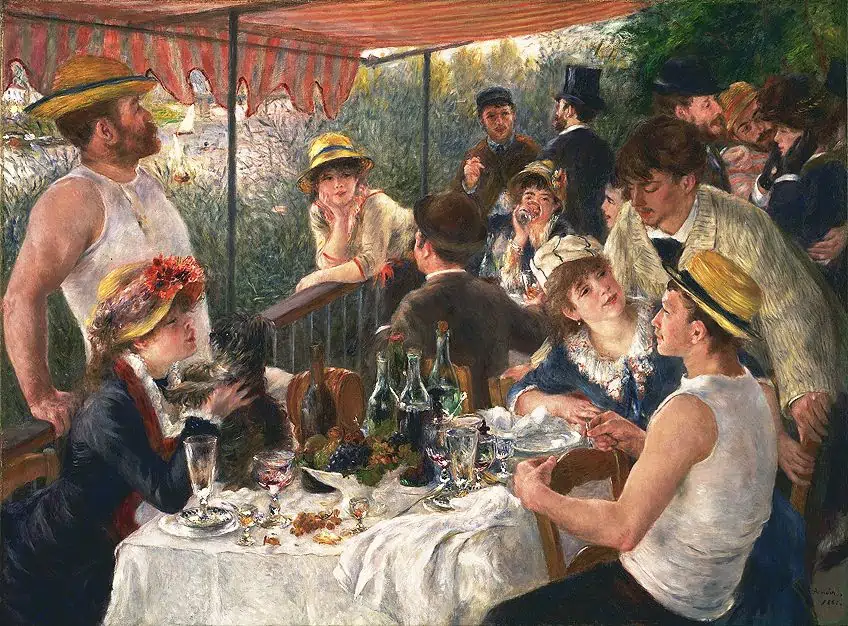
As the Modern and Contemporary eras developed in world history, so too did it draw a line between the old and new in art. Women took a stand for their rights and this was reflected in their art as they not only celebrated their own challenges with courage and raw honesty but also those of others. We see this particularly in the poignant paintings from Mexican Frida Kahlo, and the controversial contemporary pieces like The Dinner Party (1974 to 1979) by Judy Chicago.
There have also been numerous female artists throughout the ages, creating new standards and places for women beyond the perceptions of nurturers and nudes.
Important female artists included Artemisia Gentileschi, Sofonisba Anguissola, Lavinia Fontana, Catharina van Hemessen, Judith Leyster, Berthe Morisot, Mary Cassatt, Hannah Höch, Frida Kahlo, Georgia O’Keeffe, and Cindy Sherman, among many others.
Our Top 15 Famous Paintings of Women
Below we discuss 15 famous paintings of women. We have included paintings by women too as these are equally important to highlight. It is also important to note that the way men experienced women was and continues to be, vastly different from how women experienced and still experience themselves on a personal and cultural level.
So let us take a closer look at how each artist celebrated the female of choice, starting from the Renaissance to the Modern era. Please bear in mind that there is an expansive world of female art, and we are only touching the tip of the iceberg, as they say.
The Birth of Venus (c. 1484 to 1486) by Alessandro Botticelli
| Artist | Alessandro Botticelli |
| Date Painted | c. 1484 to 1486 |
| Medium | Tempera on canvas |
| Dimensions | 172.5 x 278.9 centimeters |
| Where It Is Currently Housed | Uffizi Gallery, Florence, Italy |
The Birth of Venus was painted by the Italian Renaissance painter Sandro Botticelli between 1485 and 1486. Here we see Venus, the famous Greek goddess, standing on a large shell being welcomed to shore by the God of wind, Zephyr, who is holding a female figure thought to be Chloris, a nymph he married, on the left. Hora stands on the right.
The Venus figure herself is depicted with a characteristically coy and bashful demeanor; her left hand (our right) rests gently over her genitalia and similarly, her right hand (our left) covers her breasts. This was thought to refer to the Classical female stance called Venus Pudica.
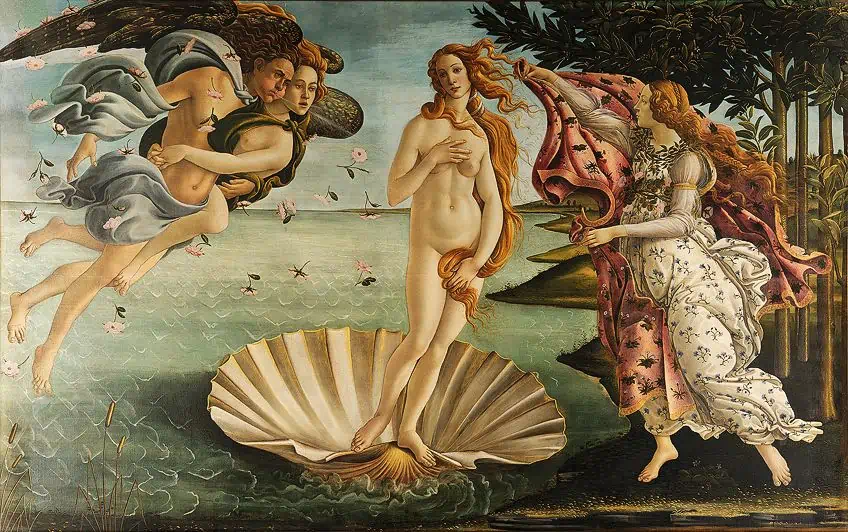
The Birth of Venus is a large-scale painting and depicts a female nude that was not typically accepted for such large-scale paintings, which would often depict religious scenes. However, this is a female nude in a mythological scene.
The Mona Lisa (1503) by Leonardo da Vinci
| Artist | Leonardo da Vinci |
| Date Painted | 1503 |
| Medium | Oil on panel |
| Dimensions | 77 x 53 centimeters |
| Where It Is Currently Housed | The Louvre, Paris, France |
The Mona Lisa (1503) was painted by the famous Leonardo da Vinci, one of the masters of the High Renaissance in Italy. It is an eloquent yet ambiguous portrait of Lisa Gherardini, also known as Lisa del Giocondo; who was apparently married to Francesco del Giocondo.
The painting is titled La Gioconda in Italian, meaning “jovial” or “happy”.
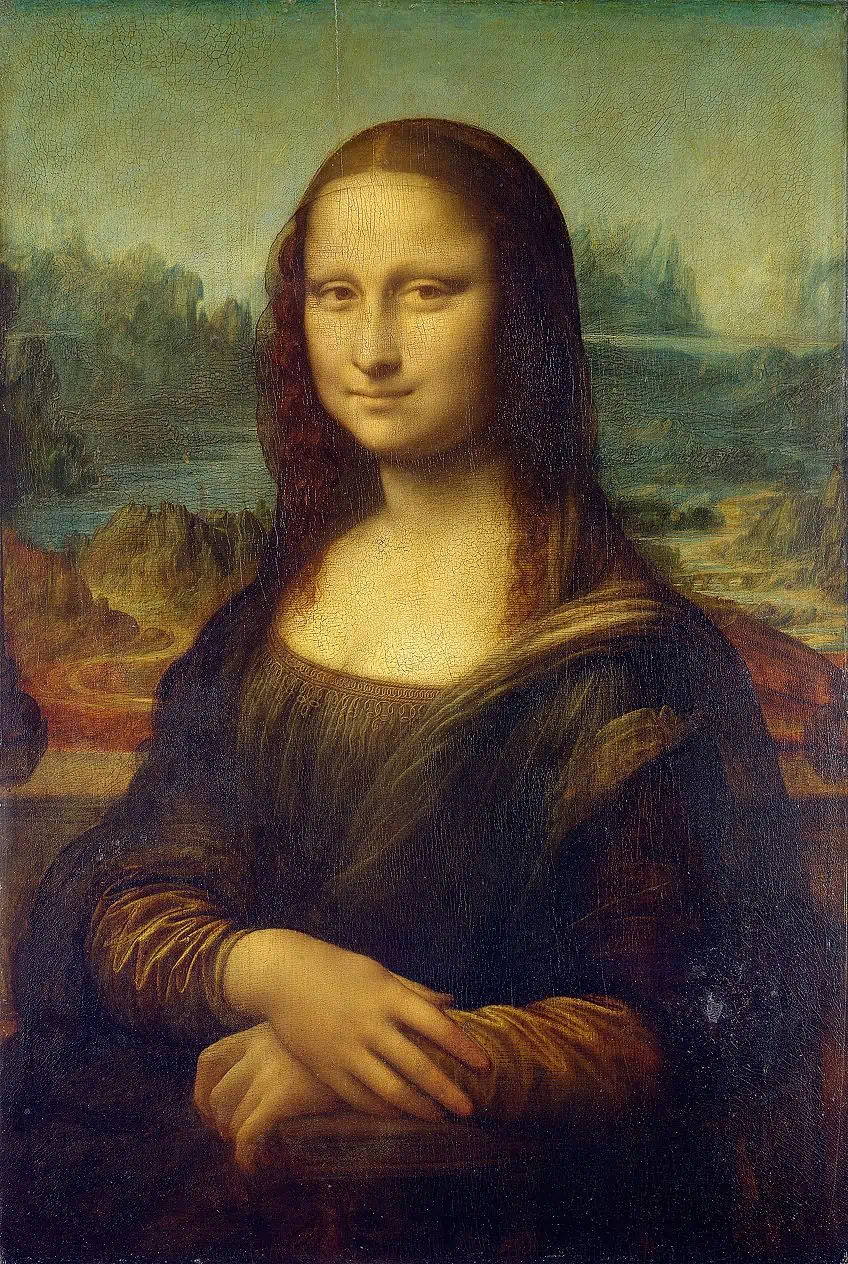
Da Vinci utilized various techniques to achieve an almost immaculate depiction of the Mona Lisa, namely, sfumato, which involved a fluid transition between colors creating the appearance of realism. Furthermore, the background also depicts an unknown landscape, which was something Da Vinci also depicted in other paintings.
Venus of Urbino (1534) by Tiziano Vecellio (Titian)
| Artist | Tiziano Vecelli (Titian) |
| Date Painted | 1534 |
| Medium | Oil on canvas |
| Dimensions | 119 x 165 centimeters |
| Where It Is Currently Housed | Uffizi Gallery, Florence, Italy |
The Venus of Urbino depicts the nude goddess Venus in a reclining pose, staring at the viewers with her left hand placed lightly over her genital area. There is also a sleeping dog depicted to the right side of the bed, which has often been thought to mean loyalty.
Venus is also depicted inside, surrounded by what appears to be opulent furniture and bedding and there are two women in the far right of the composition, possibly two maids, busying themselves in a cassone, a chest of clothes.
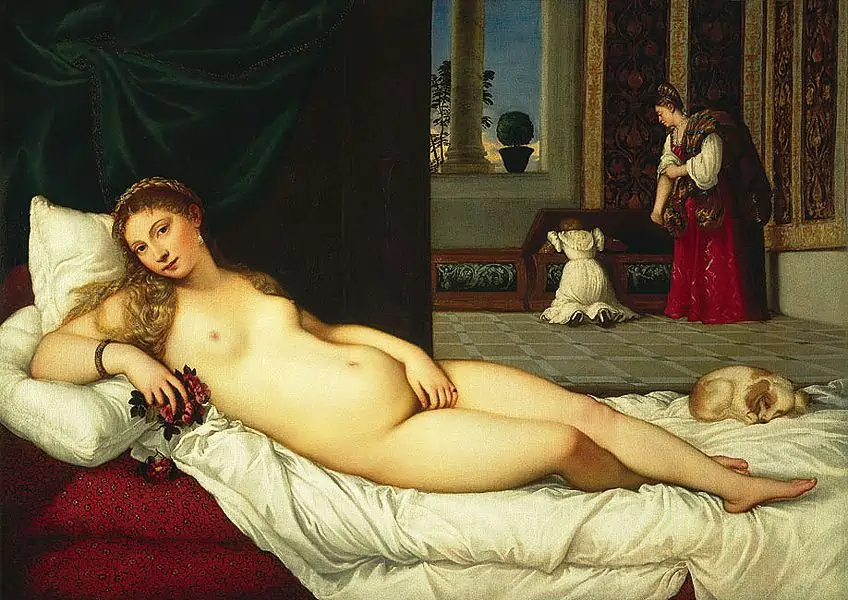
The story behind this famous reclining Venus has been debated; sources state that it may have been the depiction of a woman named Angela Zaffetta, and some believe it may have belonged to a man named Guidobaldo II della Rovere as a celebration of his marriage. It was believed that Venus was also depicted after the painting titled, The Sleeping Venus (c. 1510) by Italian artist Giorgione.
Titian’s Venus of Urbino has become a famous depiction of the reclining nude female figure, inspiring many other artists to create compositions with the theme. One of these has been Olympia (1863), painted by Édouard Manet.
Judith Slaying Holofernes (1614 – 1621) by Artemisia Gentileschi
| Artist | Artemisia Gentileschi |
| Date Painted | c. 1611 to 1612 |
| Medium | Oil on canvas |
| Dimensions | 158.8 x 125.5 centimeters |
| Where It Is Currently Housed | Museo di Capodimonte, Naples, Italy |
Artemisia Gentileschi painted during the Baroque period and became one of the most famous ad prestigious female artists from an early age. What made her unique was her accomplished career in the arts. Her painting style has been known to be more realistic with subject matter focused on women from religious stories, mythology, and various other narratives.
Her skill has also been attributed to the famous Italian painter, Caravaggio.

Judith Slaying Holofernes is one of Gentileschi’s most popular paintings, depicting the story from the Old Testament in the Bible when Judith beheaded Holofernes, who was an Assyrian general. In the painting, we see in detail how Gentileschi depicted the moment when Judith cuts her antagonist’s neck, with her servant, Abra, assisting her by pinning Holofernes down.
Some sources state that the meaning around this painting was either around Gentileschi’s focus on depicting women as strong and brave, whilst others have speculated that it may have stood for the artist’s “revenge”.
This was believed to be a form of catharsis, so to say, of when she was raped by the painter Agostino Tassi. Furthermore, this painting is just one of many examples depicting women with power not only in the narrative but also with the power of choice over what they want to paint.
Girl with a Pearl Earring (c. 1665) by Johannes Vermeer
| Artist | Johannes Vermeer |
| Date Painted | c. 1665 |
| Medium | Oil on canvas |
| Dimensions | 44.5 x 39 centimeters |
| Where It Is Currently Housed | Mauritshuis, The Hague, Netherlands |
Johannes Vermeer, who was known as a Baroque painter and Dutch Golden Age painter, was highly regarded for his artistic skill in utilizing colors to portray light and textures. Apparently, his nickname was “Master of Light”. He also painted various genre scenes depicting people from different classes, as well as portraits.
The Girl with a Pearl Earring painting became one of Vermeer’s most famous artworks. It was known as a “tronie” painting, which was not a proper portrait of someone, but rather a work with exaggerated facial features. These paintings depicted human emotions and characteristics through this emphasis.
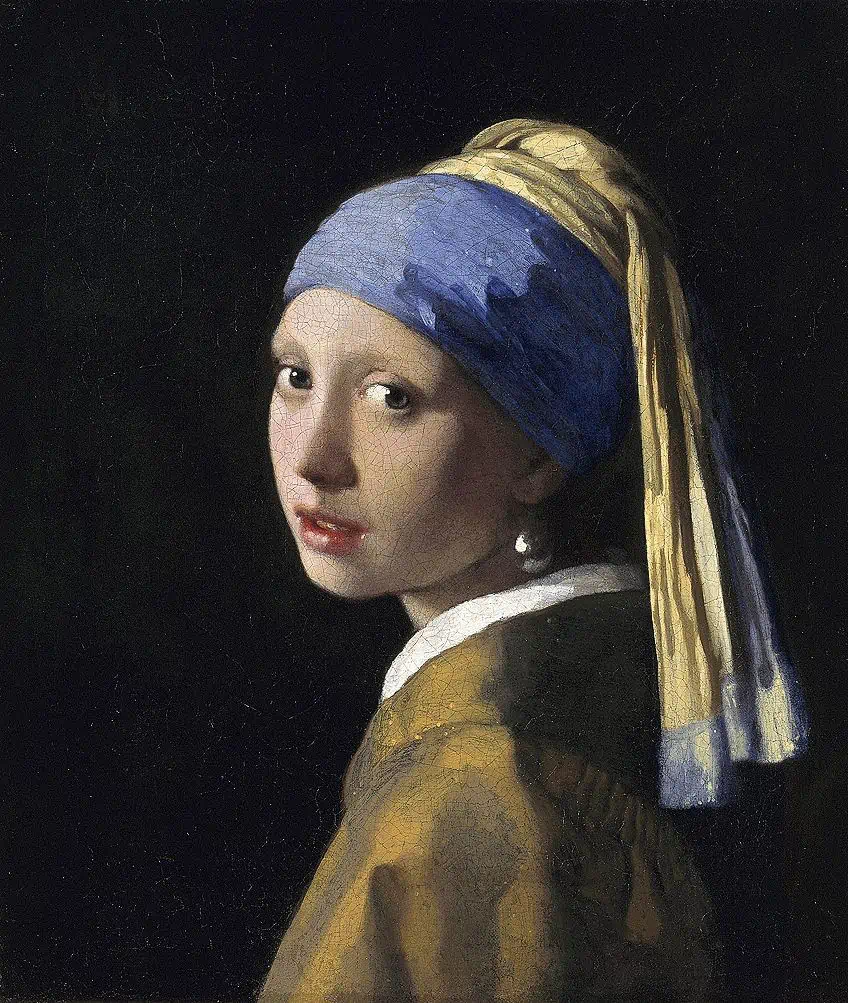
This also often depicted the exotic or “Oriental”. We see the latter characteristics portrayed in the girl’s turban. She is also wearing a large round earring on her left ear; however, some say it was tin rather than a pearl, and she is looking at the viewer with an animated facial expression.
La Grande Odalisque (1814) by Jean Auguste Dominique Ingres
| Artist | Jean Auguste Dominique Ingres |
| Date Painted | 1814 |
| Medium | Oil on canvas |
| Dimensions | 88.9 x 162.56 centimeters |
| Where It Is Currently Housed | Louvre, Paris, France |
The French Jean Auguste Ingres was known as a Neoclassical and Romanticism painter. He was known to “abstract” the forms of the human figure in his paintings, which gave his subject matter more emotional expressions and emphasized features. Some say his artworks laid the foundations for the Modern era in art due to his more expressive style.
In his oil painting La Grande Odalisque, we see the female nude figure. She is depicted with her back to us, the viewers, while also staring pointedly in our direction. What has made this painting so unique was how Ingres portrayed the concubine with exaggerated anatomical features.
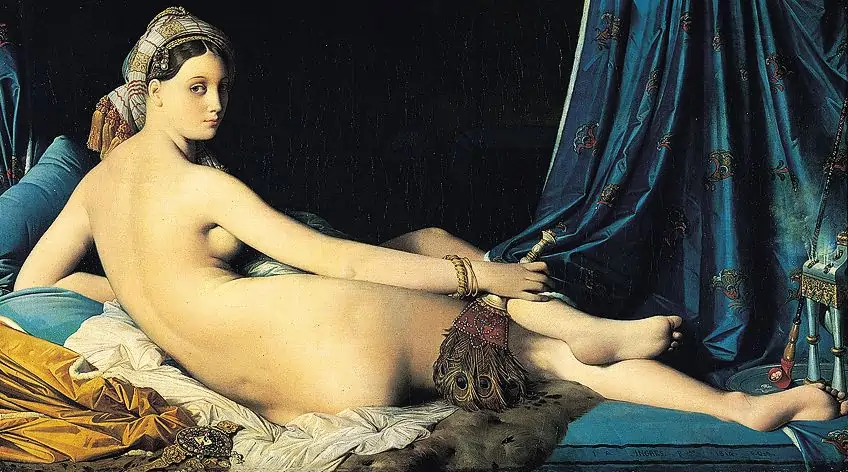
Namely, her back is too elongated and many art historical sources state that that depiction of elongation would require several more vertebrae. Additionally, her left leg is at a disproportionate angle with her hips and right leg.
La Grande Odalisque, as enchanting and peculiar as this painting is in its realism, has become one of the icons of female figures, taking its place alongside the many other depictions of Venuses and eroticized women like Titian’s Venus of Urbino, mentioned above.
Furthermore, it is also a representation of what has been known as the “Oriental” subject, which made the nakedness of the female more acceptable because it was deemed “exotic”. This was also during the time when the French Empire colonized the Orient, which comprised of places like the Near East and Turkey.
Liberty Leading the People (1830) by Eugène Delacroix
| Artist | Eugène Delacroix |
| Date Painted | 1830 |
| Medium | Oil on canvas |
| Dimensions | 260 x 325 centimeters |
| Where It Is Currently Housed | Louvre, Paris, France |
Eugène Delacroix was known as a Romantic painter. His style was characterized by an expressive use of brushstrokes, bright and strong use of colors, and a dynamism of composition and subject matter that ranged from Oriental to historical. His work was considered opposite in style to the previously mentioned Ingres. We will notice his emotive and passionate artistic style in one of his iconic paintings, Liberty Leading the People.
The main protagonist here is a female, holding up the French flag in her right hand (our left) and a musket with a bayonet in her left hand (our right). She is wearing what is known as a Phrygian cap, which symbolized freedom. We see her leading a group of men on a battleground with numerous dead bodies under their feet.
Liberty Leading the People (1830) by Eugène Delacroix; Eugène Delacroix, Public domain, via Wikimedia Commons
There is also an indication of a cityscape in the background. Delacroix painted the female as a symbol and personification of liberty. It was in honor of the 1830 French Revolution, which was known as the Second French Revolution (the first was in 1789).
Delacroix placed the female figure in a powerful position: she was depicted not only as a leader but also as a woman in her wildness with her breasts completely revealed by her open dress and her feet bare. She is seemingly unperturbed by the elements, both natural and man-made, around her.
She was also believed to be a representation of Marianne, who was a figure that symbolized liberty, known as a “republican symbol”.
Olympia (1863) by Édouard Manet
| Artist | Édouard Manet |
| Date Painted | 1863 |
| Medium | Oil on canvas |
| Dimensions | 130.5 x 190 centimeters |
| Where It Is Currently Housed | Musée d’Orsay, Paris, France |
One of the forefathers of Impressionism, Édouard Manet, introduced to the world a new spin on the female nude, so to say. Presenting Venus in complete confidence compared to the traditionally bashful and coy Venus figure that we came to know from the Classical periods, Manet painted Olympia.
It was not only the subject matter that caused an uproar among art critics during the 19th century, but it was also Manet’s artistic style that contributed to the Modern era of art.
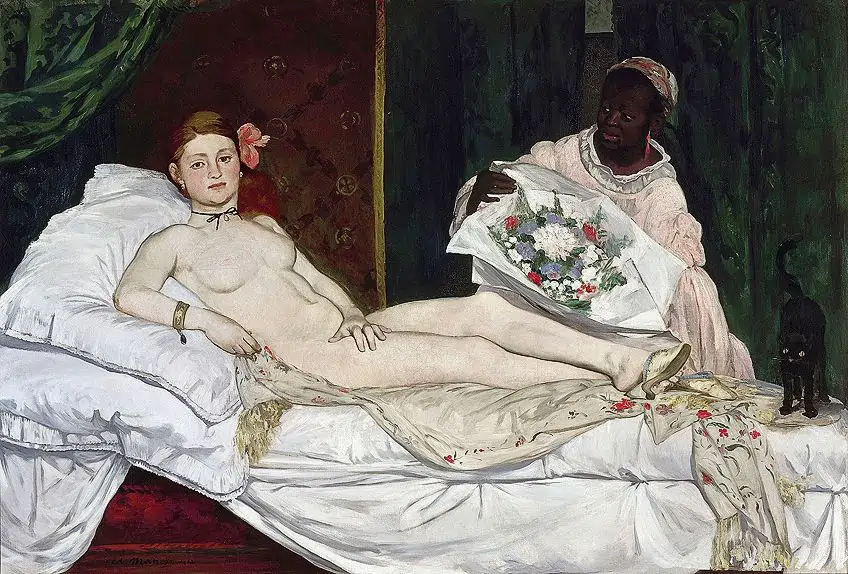
In Olympia, we see a reclining nude woman who stares at the viewer in a gaze unthwarted by any potential coyness that may result from her nudity. As she seemingly elegantly leans against her pillow, her maidservant is standing to the right presenting her with a bouquet of flowers. What made this painting controversial when it was first presented to the public at the Salon in Paris in 1865 was that Manet depicted a prostitute, denoted not only by the name but through the various items she wore.
Olympia was inspired by Titian’s Venus of Urbino, however, in Manet’s version, the female figure’s left-hand rests more decisively near her genital area compared to the lighter gesture in Titian’s version. The model who posed for Manet was French artist Victorine-Louise Meurent.
Whistler’s Mother (1871) by James McNeill Whistler
| Artist | James McNeill Whistler |
| Date Painted | 1871 |
| Medium | Oil on canvas |
| Dimensions | 1,443 x 1,624 millimeters |
| Where It Is Currently Housed | Musée d’Orsay, Paris, France |
Whistler’s Mother, also titled Arrangement in Grey and Black No.1, is a depiction of artist James McNeill Whistler’s mother, who was Anna McNeill Whistler. The artist painted her sitting in profile, wearing a black dress and white lace hat; while holding a handkerchief in her hands that are resting on her lap.
We see only slight surroundings of the interior, such as the curtain to the right, and a painting on the wall, which has been thought to be Whistler’s painting about the Thames.
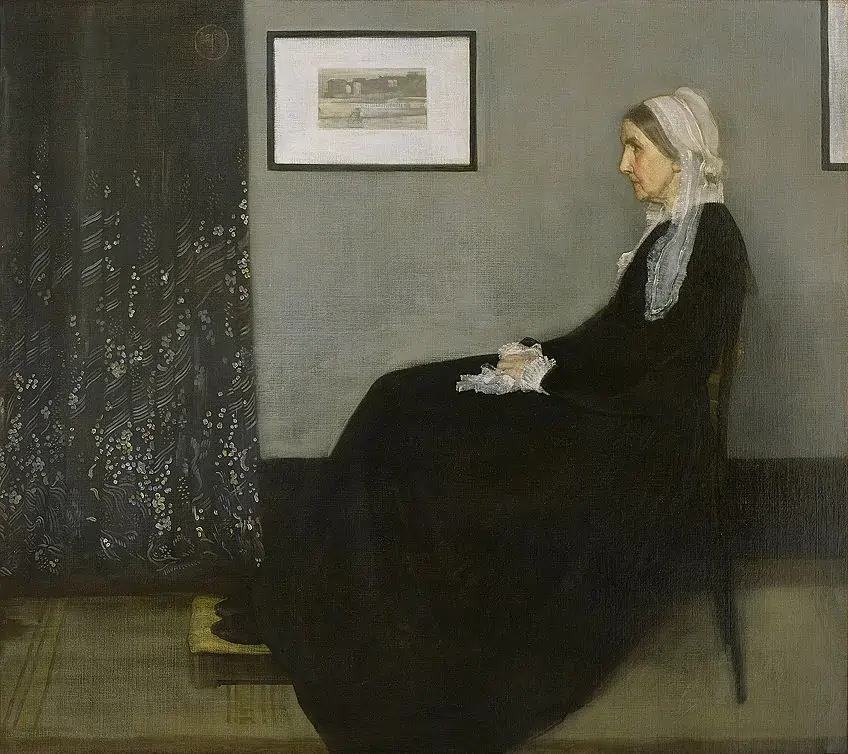
It has appeared in numerous films, series, and music. Notable films include Bean (1997), I Am Legend (2007), and The Simpsons in episodes like Rosebud (1993) among others. Apparently, Whistler’s mother sat for the artist when the scheduled model canceled their appointment.
Whistler’s Mother has become one of the most iconic female portraits of the 19th century.
The Cradle (1872) by Berthe Morisot
| Artist | Berthe Morisot |
| Date Painted | 1872 |
| Medium | Oil on canvas |
| Dimensions | 56.1 x 46 centimeters |
| Where It Is Currently Housed | Musée d’Orsay, Paris, France |
Berthe Morisot became a notable female artist who worked within Impressionism. As a female painter, she produced numerous paintings about everyday scenes and people such as other women and their way of life, children, and nature. These were all done in the characteristic Impressionist en plein air (outdoor) style. She utilized a range of media like watercolors, pastels, oils, as well as pencil and charcoal. Her style was also influenced by the prevalent Japonism movement at the time.
In The Cradle painting, Morisot painted her sister, Edma, and her baby Blanche. This painting has been described as one of Morisot’s most famous.
The Cradle (1872) by Berthe Morisot; Berthe Morisot, Public domain, via Wikimedia Commons
We see how Edma sits, staring at her child, who is covered from our full view by the white curtain. Edma’s gaze and thoughtful demeanor have also been interpreted in different ways, some suggesting that she is longing for the days as a painter herself, before she got married.
Woman with a Parasol (1875) by Claude Monet
| Artist | Claude Monet |
| Date Painted | 1875 |
| Medium | Oil on canvas |
| Dimensions | 100 x 81 centimeters |
| Where It Is Currently Housed | National Gallery of Art, Washington, DC |
Woman with a Parasol depicts Claude Monet’s wife Camille Monet and their son, Jean Monet, standing on a small hill while they were taking a walk. This was painted during the 1870s, which was when Monet apparently lived in Argenteuil in Paris.
This has become one of Monet’s most iconic paintings and examples of Impressionism and the en plein air, or outdoor, style of painting.
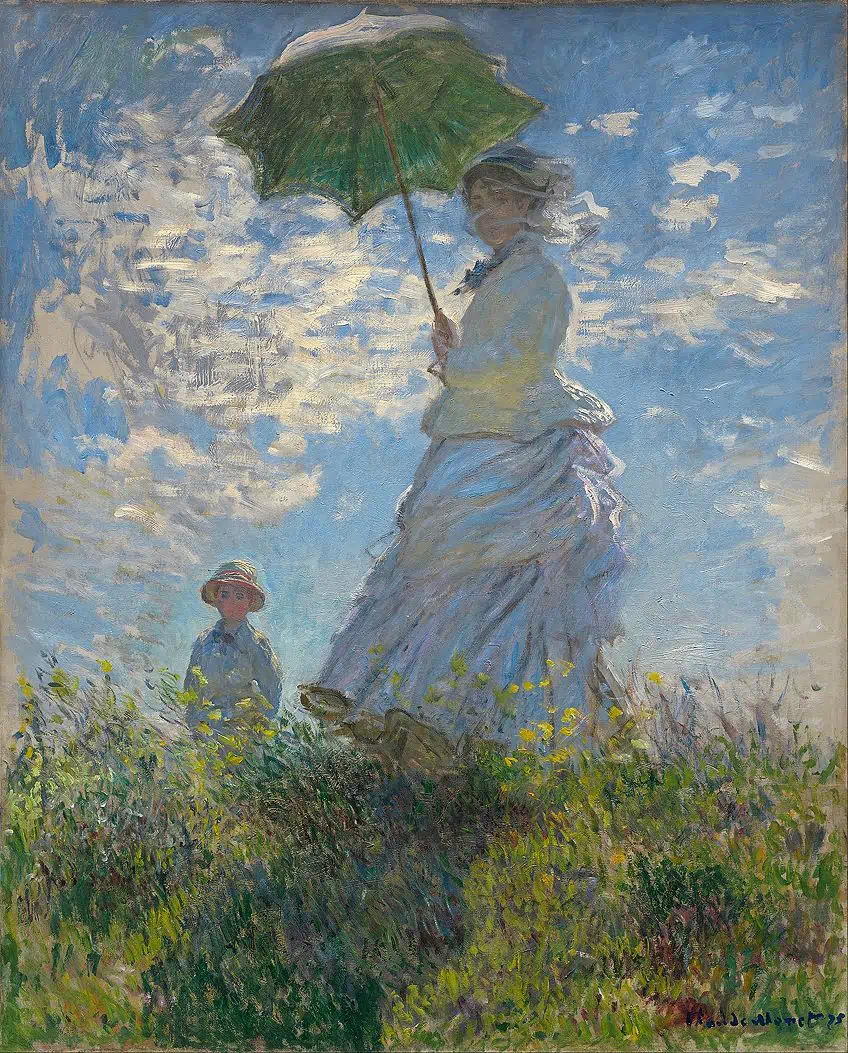
Monet reportedly painted Woman with a Parasol in one sitting and created a dazzling depiction of the outdoor light. We see the woman holding a parasol, standing against the sunlight, which creates further shadowing. Furthermore, Monet painted from an angled perspective, placing his subject higher up, creating the effect that we, the viewers, are looking up at them.
Monet produced similar paintings during 1886, using Suzanne Monet as his model.
Portrait of the Artist (1878) by Mary Stevenson Cassatt
| Artist | Mary Stevenson Cassatt |
| Date Painted | 1878 |
| Medium | Watercolor and gouache |
| Dimensions | 60 x 41.1 centimeters |
| Where It Is Currently Housed | The Metropolitan Museum of Art (MET), New York City, United States |
Born in Pennsylvania, Mary Stevenson Cassatt painted everyday scenes of women, notably with their children, while she explored themes around motherhood. Cassatt traveled and lived in Europe (specifically France) for a large part of her life, where she studied and learned from the great masters of the arts.
She painted as an Impressionist and was a leading figure in introducing this style to America. She was also described as part of the “three great ladies” of Impressionism, the other two being Berthe Morisot and Marie Bracquemond.
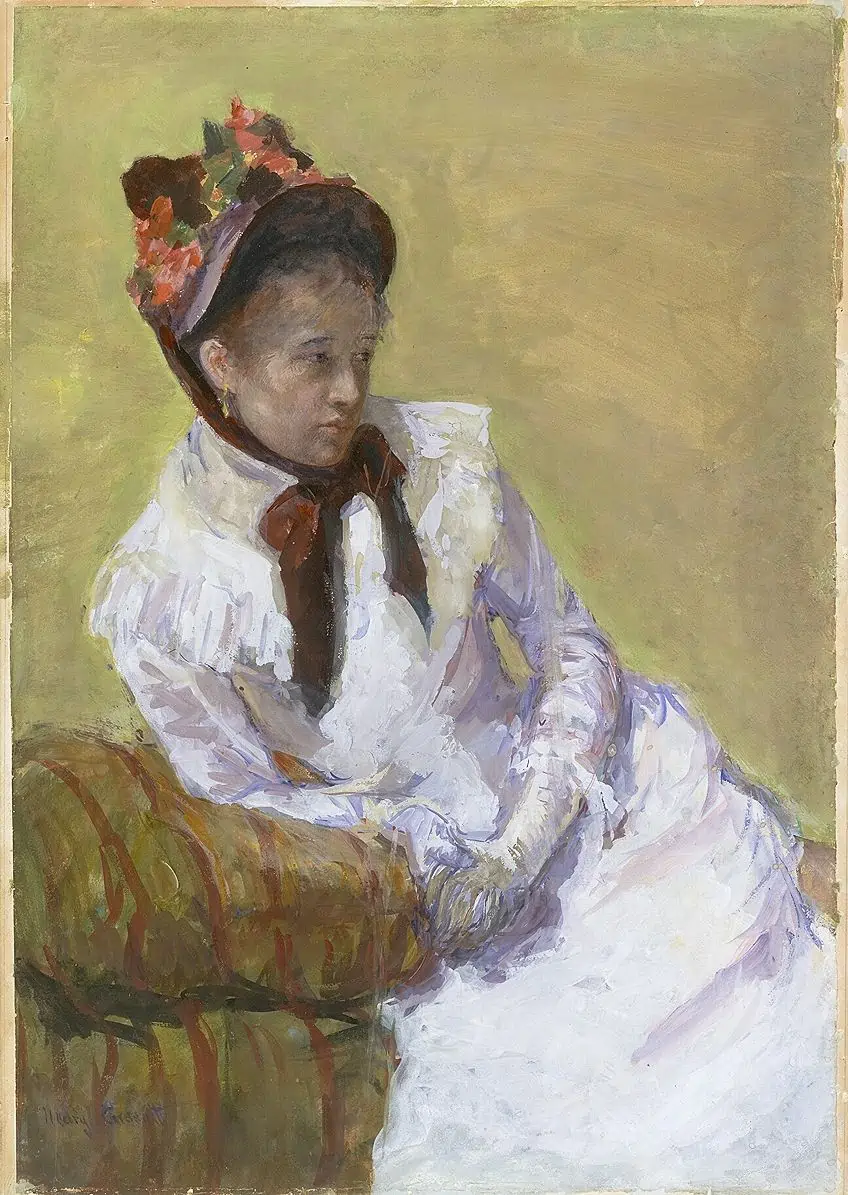
In Portrait of the Artist, we see the example of a woman painting herself, produced with watercolors and gouache, which also tells of Cassatt’s utilization of mixed media throughout her art career. Some sources believe that this self-portrait was produced when Edgar Degas also painted a portrait of Cassatt, titled Mary Cassatt Seated, Holding Cards (c. 1884).
Portrait of Gertrude Stein (1905 – 1906) by Pablo Picasso
| Artist | Pablo Picasso |
| Date Painted | 1905 to 1906 |
| Medium | Oil on canvas |
| Dimensions | 100 x 81.3 centimeters |
| Where It Is Currently Housed | The Metropolitan Museum of Art (MET), New York City, United States |
Portrait of Gertrude Stein has been one of Pablo Picasso’s popular female portraits to date. The subject of this painting was as the title suggests, Gertrude Stein. She was an American and lived in Paris, which is where she and Picasso met during 1905. Stein was a prominent writer, poet, and art collector, among many other accolades. She bought numerous paintings from Picasso and has been remembered as playing a seminal role in the artist’s success.
What made this painting unique was that Picasso did not paint it as a traditional portrait.
For example, Stein is sitting with her arm resting on her leg and she stares in another direction and not directly at us, the viewers. It also does not have the same formality compared to typical portraits. This was painted during Picasso’s “Rose Period” and when he was reportedly influenced by Primitive art styles, which would explain Stein’s facial rendering appearing mask-like.
Portrait of Adele Bloch-Bauer I (1907) by Gustav Klimt
| Artist | Gustav Klimt |
| Date Painted | c. 1903 to 1907 |
| Medium | Oil on canvas with silver and gold |
| Dimensions | 138 x 138 centimeters |
| Where It Is Currently Housed | Neue Gallery, New York, United States |
Portrait of Adele Bloch-Bauer I by Gustav Klimt, also titled The Woman in Gold and The Lady in Gold, was painted during Klimt’s artistic “Golden Phase”. The model was Adele Bloch-Bauer, who also posed for Klimt in other paintings, for example, Judith I (1901), and a second version of the portrait during 1912.
Bauer was married to Ferdinand Bloch-Bauer, who was a wealthy Viennese businessman.

The first portrait of Adele is depicted in an abstracted and decorative style, characteristic of Klimt. We see her sitting on a chair; however, we cannot distinguish the chair in all its detail. Similarly, we cannot distinguish the model’s golden dress from the golden wall behind her.
Klimt utilized gold leaf and silver in his paintings and was one of the leading figures in the Art Nouveau movement. He produced numerous other female portraits throughout his artistic oeuvre.
Self-Portrait with Thorn Necklace and Hummingbird (1940) by Frida Kahlo
| Artist | Frida Kahlo |
| Date Painted | 1940 |
| Medium | Oil on canvas |
| Dimensions | 47 x 61 centimeters |
| Where It Is Currently Housed | Harry Ransom Center, Austin Texas, United States |
Frida Kahlo has become a legendary female art figure. She was born in Mexico and lived a life as rich as her paintings, and her paintings depicted her deep inner life and emotions. She was involved in a fatal car accident during her later teen years, which left her with chronic pain and spinal problems for the rest of her life.
She was married to Diego Rivera, a well-known Mexican artist, of whom she divorced and remarried.
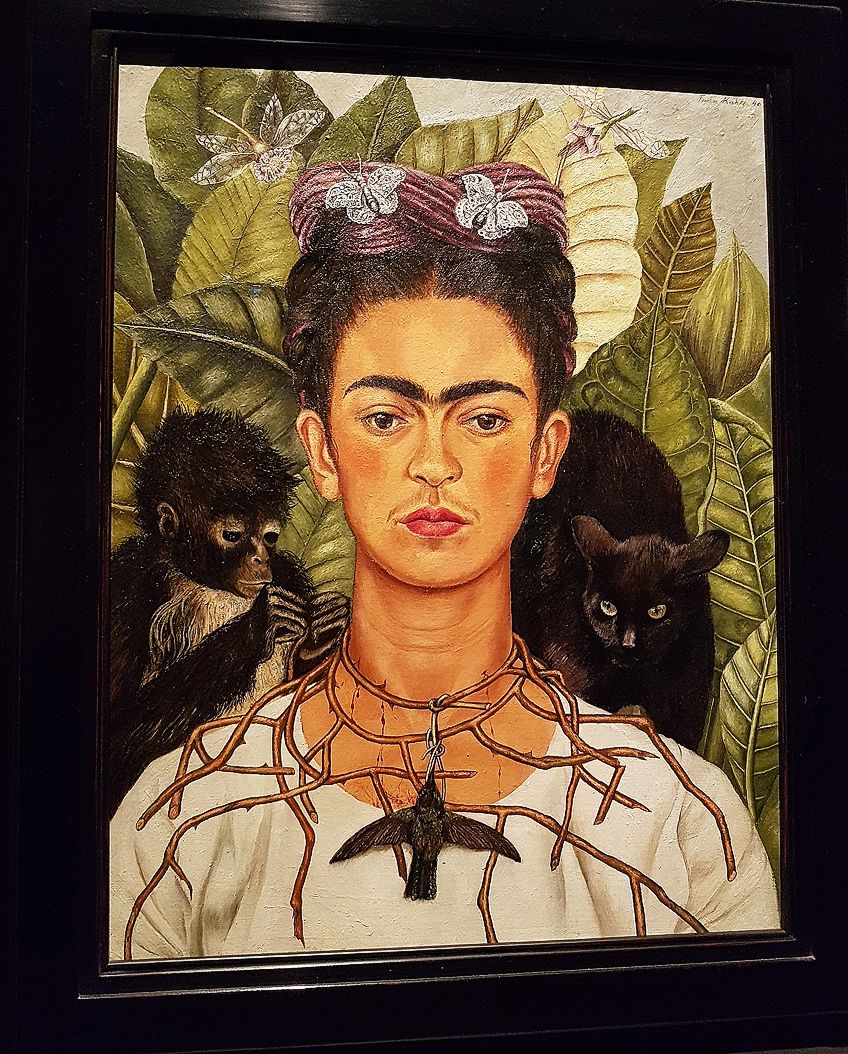
It was during her divorce to Rivera that she painted a self-portrait, among many others, titled Self-Portrait with Thorn Necklace and Hummingbird. Here we see Kahlo staring directly at us, there is a black cat by her left (our right) shoulder, a spider monkey by her right (our left) shoulder, a dead hummingbird hanging from her thorny necklace, and other insects and foliage around her.
It was a common trait of Kahlo’s to utilize various motifs of animals and foliage as symbols, as well as Mexican mythology. In this painting, the various symbols could suggest the artist’s feelings of frustration, sadness, and heartbreak.
The spider monkey was reportedly a gift to Kahlo from Rivera, which could be a symbol of him here. Kahlo was assuredly a female artist that inspired and motivated many others to create art without any pretense, as we see in just one of many here.
Women in Art and Art in Women
Although we only introduced 15 of the more famous paintings of women and female portraits in the article above, by men and women artists, we should not forget all the other hundreds of examples strewn like jewels throughout the sands of art history.
Women in art have been one of the most common subjects, as well as one of the most contested due to the role of women in human society, politics, economy, and culture. As mothers, daughters, wives, caretakers, lovers, objects of affection, and agents of their own lives, there will always be art in women as much as we will have women in art.
Take a look at our paintings of women webstory here!
Frequently Asked Questions
What Is the Most Popular Painting Depicting a Woman?
The Mona Lisa (1506) by Leonardo da Vinci has been regarded as one of the most famous paintings of a woman. It has become an icon of the Renaissance art period and the artistic skill with which da Vinci painted, rendering the Mona Lisa with realism and entrancing beauty. The Mona Lisa has become popular for her enigmatic smile.
Who Were the Most Famous Female Painters?
Among thousands, some of the most famous names in the genre of female painters throughout the history of art in the West have been, namely, Angelica Kauffman, a Neoclassical painter; Artemisia Gentileschi, who painted during the Baroque era; Mary Cassatt, who painted during the Impressionist art period; Frida Kahlo, who was a Mexican Magical Realist painter; Georgia O’Keeffe, who was a seminal female Modern artist, as well as the contemporary Judy Chicago, who is one of the leading Feminist artists of our time.
What Is the Dutch Mona Lisa?
The famous painting of a woman by the Dutch artist Johannes Vermeer, Girl with a Pearl Earring (1666), has been nicknamed the Dutch Mona Lisa because of the inherent mystery of the subject, which is the girl, as well as Vermeer’s skillful artistry in depicting what is known as a Tronie painting, which is not a traditional portrait painting. This painting has also become an icon in films, television, and books.
Jordan Anthony is a Cape Town-based film photographer, curator, and arts writer. She holds a Bachelor of Art in Fine Arts from the University of the Witwatersrand, Johannesburg, where she explored themes like healing, identity, dreams, and intuitive creation in her Contemporary art practice. Jordan has collaborated with various local art institutions, including the KZNSA Gallery in Durban, the Turbine Art Fair, and the Wits Art Museum. Her photography focuses on abstract color manipulations, portraiture, candid shots, and urban landscapes. She’s intrigued by philosophy, memory, and esotericism, drawing inspiration from Surrealism, Fluxus, and ancient civilizations, as well as childhood influences and found objects. Jordan is working for artfilemagazine since 2022 and writes blog posts about art history and photography.
Learn more about Jordan Anthony and about us.
Cite this Article
Jordan, Anthony, “Famous Paintings of Women – The 15 Most Famous Female Portraits.” artfilemagazine – Your Online Art Source. February 10, 2022. URL: https://artfilemagazine.com/famous-paintings-of-women/
Anthony, J. (2022, 10 February). Famous Paintings of Women – The 15 Most Famous Female Portraits. artfilemagazine – Your Online Art Source. https://artfilemagazine.com/famous-paintings-of-women/
Anthony, Jordan. “Famous Paintings of Women – The 15 Most Famous Female Portraits.” artfilemagazine – Your Online Art Source, February 10, 2022. https://artfilemagazine.com/famous-paintings-of-women/.


